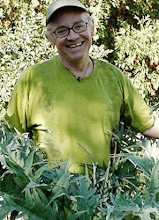 February Gold Daffodils
February Gold Daffodils Parsley un-thinned
Parsley un-thinned Parsley Thinned
Parsley Thinned Micro-greens
Micro-greens Visions of Boiled New Potatoes
Visions of Boiled New Potatoes
After a long dry spell some April showers have come and we certainly need the rain. The blooming daffodils mean the Ramps ( Wild Leek - Allium tricoccum) are up in the woods and it's time for a wild harvest. Always remember to ask to harvest on private land and never over harvest. Besides a good handful of Ramps will probably be enough if you are the only one that eats them - they are strong and make one a bit odoriferous, rather like good garlic.
The warm sunny days have really caused seedlings to grow and now is thinning time. I like to do thinning before the first set of true leaves appear. That way I can transplant later if I run into problems. That has happened to several packs of parsley. The parsley was thinned at two plants per cell. Yesterday a couple of nine packs suffered from drying out past the point of revival so I will transplant from other packs that still have two plants per cell. This is really a backup system. Leaving two plants per cell and thinning early allows for transplanting as the first set of true leaves appear. Expect some problems with seedlings during the growing season and think ahead as to solutions. Sometimes that comes down to re-seeding.
The video this week shows thinning. I am thinning lettuce at one or two plants per cell. Some lettuce transplants are not thinned as I plant them into the garden that way to allow for clump harvest of lettuce. Bibb and Romain and other head varieties are best thinned but leaf and varieties like Simpson Elite I like in clumps because they are harvested as young leaf bunches.
The tray of lettuce seedlings will be thinned and then moved outside into the cold frame as lettuce is much happier in a cool environment.
The peppers and tomatoes are at the same point of thinning. Some have been thinned to two plants per cell and as the first true leaves appear the strongest, most vigorous, and best plant of the two will be kept. Sometimes that plant is not the tallest but a plant with good color and a thick stem. I am not looking for tall pepper or tomatoes; I am looking for sturdy plants that will continue to grow vigorously as they are moved into the next pots before June planting out.
The key to thinning is pick the seedlings that you want to keep then pull the rest. That is why I use a tweezers. Move the keepers aside and pull the others. Early in the process the roots are not developed well and the seedlings even close together will separate and come out easily. It is best not to do this task with dry soil; so water and then thin. Be ruthless, the survivors will be happy and they will grow nicely for you.
I have included pictures of the micro-greens trays that have really appreciated being outside and will soon be ready for harvest. We are close to the point of not needing store-bought leafy vegetables. Spinach, arugula, sorrel, and lettuce and the micro-green trays are all available for cutting and the first seeding of lettuce will soon be sized for transplanting into the garden so we are already on our way.
This summer, potatoes return to the garden space and the first of them have arrived in the mail. They are to be part of a experiment with tower growing. For the last two summers, we have tried sweet potatoes with poor results. Our ground is too heavy, and I feel, too cold. Even in soil bags growing in the shelter of my small greenhouse our success was poor. So, we have returned to regular potatoes and will experiment with growing them again but will try growing potatoes vertically to save on ground space. I will keep you updated on that endeavor.
Happy Gardening
A Thinning Method

Saw your URL in the GB PressGazette. I added it to my Google Reader so will be updated when you do. Keep up the good work.
ReplyDeleteI have 12 raised beds along with my berry bushes. 4 asparagus, 2 garlic and the rest rotated with tomato, pepper, brassica, legumes, and greens.
We have 6 brassica plants in (3 broccoli, 3 brussel sprouts) along with peas, lettuce, beets, and spinach.
I can't wait.
Ah, garlic beds - I have 2 areas with garlic too, it's up and looks like I might have a nice harvest in late summer. My broccoli seeds have sprouted so that crop too is on its way. Welcome and Happy Gardening
ReplyDelete